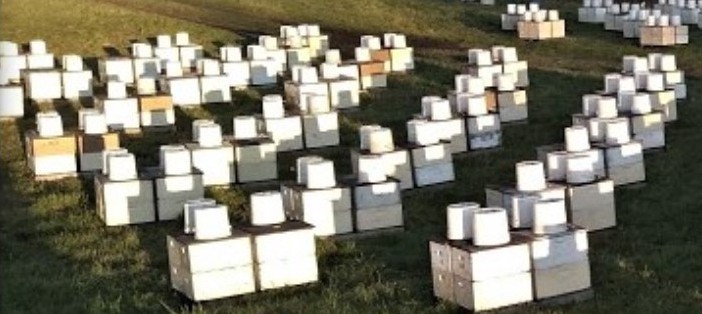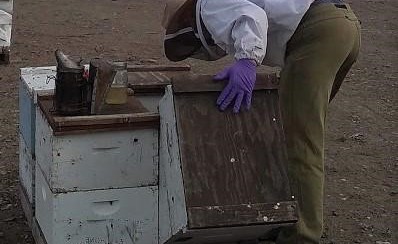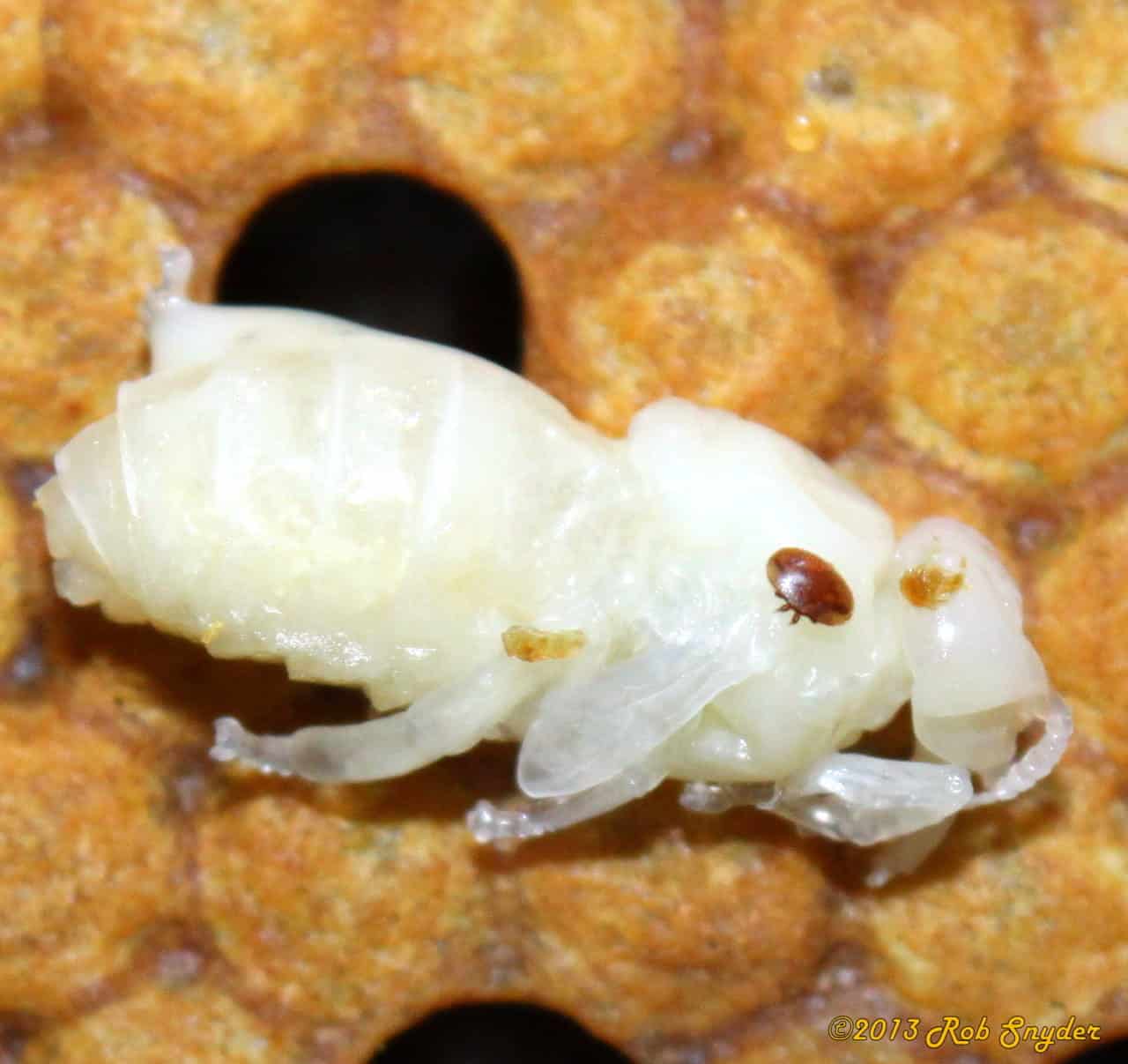A colony of bees is fairly loose in their requirements of a cavity to live in. Basically they need a space of a suitable volume with a defensible entrance and enough protection from the elements so they can maintain an internal environment to survive in good health. A lid for the hive helps meet this last requirement by helping to retain heat and exclude precipitation. At its simplest, a lid can just be a piece of plywood or other material that provides coverage to the top of a hive. Beyond meeting the basic needs of the colony, beekeepers have added modifications to lid and cover…
Category: Basic Beekeeping
Look Down
Separating a hive from the bottom board and tilting it forward is a useful first step before proceeding further with a colony inspections for several reasons. A tilt allows you to assess the overall weight of a hive while letting the bottom board carry the weight. Tilting also facilitates looking at the bottom bars to assess the coverage and density of bees allowing for a population estimate to be made. These are both valuable pieces of information that allow broad inferences about colony health to be made, but tilting the hive forward before proceeding further also allows you to examine the state of the bottom…
Nitrile Gloves and You
When asked "Besides a hive tool, a smoker and a veil, what is your favorite tool in the beekeeper's toolbox?" fellow BIP field specialist Dan Aurell replied with NITRILE GLOVES! There are a lot of situations where a beekeeper (especially a BIP field specialist) might want to pull on some nitrile gloves. The most obvious benefit gained using nitrile gloves is that they can help prevent honey bee stings (or just make them less severe). This fact assumes that you are already going gloveless and not using thick leather gloves. They do not prevent stings outright but they can help prevent the stinger becoming embedded…
What Robbing Looks Like
Most new beekeepers find out about robbing the hard way when they either spend a little too long poking around in colonies at the wrong time of year, arrive in a bee yard already to find a frenzy of activity around hive entrances, or encounter the aftermath in the form of dead colonies and empty hives. Robbing can be particularly bad in the late summer and fall when several conditions align, leading to high potential for robbing. These triggering conditions include nectar dearth after a main flow, large colony populations with a high proportion of foragers, temperatures suitable for intense flight activity, and potential for…
The NEW Honey Bee Discovery Center in Orland
A few weeks ago, I was invited to the Honey Bee Discovery Center Kick-off and Exhibit Preview in Orland, California. This event was followed by the Queen Bee Festival the day after. The Honey Bee Discovery Center is ‘the first interactive exhibit and museum of its kind’. It highlights the history of beekeeping from hobbyists, sideliners and commercial operators’ perspectives, and features the evolution and breakthroughs in equipment, pollination and art inspired by bees. Inside the center, one can find multiple showcases of vintage bee equipment related to all apicultural activities, complete with an observation hive near the center of the room. All around the new…
New BIP Team Perspective
Forward: For my first blog post I was asked to write about my perspective of joining BIP as a tech transfer team member. I have been in the field so much that I am just now getting around to it. I hope this blog accurately captures both the factual and emotional aspects of becoming a BIP tech team member. So here it goes... It’s About The Bees! As one of the rookies on the Bee Informed Partnership (BIP) tech transfer team, I feel incredibly lucky to have joined BIP at such an interesting time for the organization, and for the beekeeping industry itself. On the first…
Why did my honey bees die?
Learning to identify a common cause of winter death in Northern Climates By Meghan Milbrath, Michigan State University Extension, March 8, 2016 Guest Blog Beekeepers in northern climates have already lost a lot of colonies this winter. While official counts won’t be recorded for a few months, some trends are starting to emerge. One of these trends is a specific type of colony death. In Michigan, I’ve received so many calls describing the scenario below, that I can describe the deadout before opening the hive, or before the beekeeper describes it over the phone. While I may impress some with these predictive powers, the…
Bee Informed Partnership Diagnosis and treatment of Common Honey Bee Diseases Wins Bronze!
At Apimondia this year our training manual for ‘Common honey bee diseases’ was submitted in the book category. This simple training manual was entered among many other highly competitive books and won a bronze award to our surprise! I originally wanted to create a honey bee disease/diagnosis manual because most of the literature had very small, poor quality photos which made disease identification difficult. So for the past 7 years I had been collecting images of the various bee diseases and pests I came across during colony inspections in Pennsylvania as well as in migratory operations around the country. In 2011, I moved to Northern…
UMD Bees All Prepped for Joaquin!
The weather forecast doesn’t look too good for this weekend with hurricane Joaquin heading to the East Coast. In expectation of high winds and rain, we have prepped our colonies at University of Maryland as best we can. The action items here are: remove unused equipment, condense weight close to the ground, strap the boxes together (and even to the hive stand, if you can), weight the top cover and beware of floods. We reduced most of our colonies to 2 deeps high as we started feeding our colonies a couple of weeks ago. This is…
Variable Efficacy of Mite Treatments?
Variable efficacy of mite treatments has been a constant battle for beekeepers in the past 28 years. However, there are some things we can do in the colony to increase a treatment’s efficacy. Many treatments available to beekeepers are spread through the hive by the bees and also by the bees fanning and ventilating the hive. This ventilation is a crucial part of the hive as a whole since pheromones are spread through the hive via ventilation and traffic from worker, queen and drone bees. Through my experience, and especially over the past 8 years, I have noticed many different types of beekeepers: there are…




